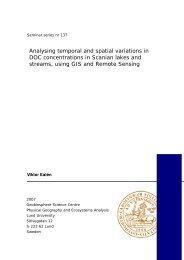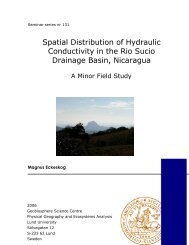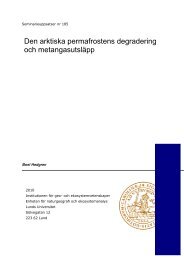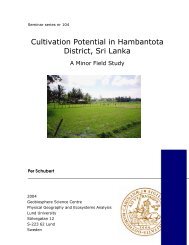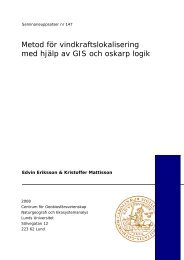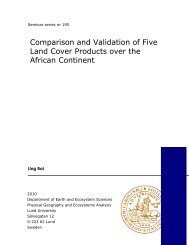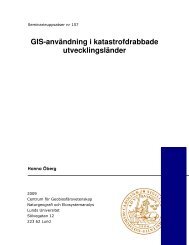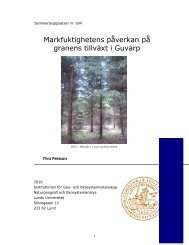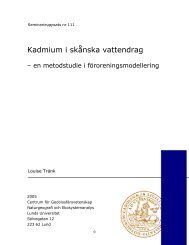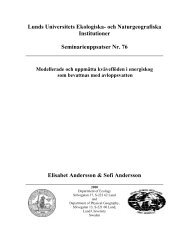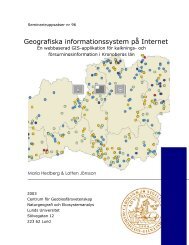Finding Potential Sites for Small-Scale Hydro Power in Uganda: a ...
Finding Potential Sites for Small-Scale Hydro Power in Uganda: a ...
Finding Potential Sites for Small-Scale Hydro Power in Uganda: a ...
You also want an ePaper? Increase the reach of your titles
YUMPU automatically turns print PDFs into web optimized ePapers that Google loves.
distributed elevation po<strong>in</strong>ts or to convert the l<strong>in</strong>es to po<strong>in</strong>ts and use a generalizationrout<strong>in</strong>e that reduces the over-representation of po<strong>in</strong>ts along the l<strong>in</strong>es. S<strong>in</strong>ce the study wasper<strong>for</strong>med under limited conditions, there was no possibility to try these differentmethods, there<strong>for</strong>e we used the ANUDEM based <strong>in</strong>terpolation method TOPOGRID <strong>in</strong>ArcGIS. Asserup and Eklöf (2000) say that when the highest possible accuracy is needed,advanced algorithms like ANUDEM offer more flexibility and higher precision, due toits dra<strong>in</strong>age en<strong>for</strong>cement algorithm and the possibility to <strong>in</strong>corporate streaml<strong>in</strong>e data <strong>in</strong>tothe <strong>in</strong>terpolation. Also Peralvo (www.crwr.utexas.edu) found, when per<strong>for</strong>m<strong>in</strong>g aquantitative comparison measurement, that TOPOGRID outper<strong>for</strong>med IDW, Krig<strong>in</strong>gand Radial Basis Functions (RBF) when creat<strong>in</strong>g hydrologically correct DEMs.TOPOGRID consistently produced high quality results <strong>for</strong> both areas with steeperslopes and well-def<strong>in</strong>ed valley bottoms as well as river junctions, which substantiate theappropriateness of the locally adaptive approach used <strong>in</strong> the algorithm.When us<strong>in</strong>g contours as <strong>in</strong>put data <strong>in</strong> the <strong>in</strong>terpolation method ANUDEM the result isof course dependent on the quality of <strong>in</strong>put data. As can be seen <strong>in</strong> Figure 5.6a, the badquality of digitalisation could have caused the loss of potential sites <strong>for</strong> small-scalehydropower stations. Bigger errors arisen by <strong>in</strong>correct digitalisation and by outliers withhigh amplitude is likely to be detected and edited and there<strong>for</strong>e not caus<strong>in</strong>g muchproblems. Hence, bad quality of contours can be critical <strong>for</strong> the outcome, but errors arerelatively easy detected and elim<strong>in</strong>ated through a visual <strong>in</strong>spection and edit<strong>in</strong>g of the data.In our study we tried <strong>in</strong>terpolations with 100, 30 and 10-meter cell size <strong>in</strong> order to reacha suitable resolution. The reason <strong>for</strong> choos<strong>in</strong>g the 10-meter resolution DEM is that it hasthe best accuracy regard<strong>in</strong>g both terra<strong>in</strong> structure and absolute elevation, compared tothe 100 and 30-meter resolution. A reason not to choose the 10-meter resolution wouldbe the slight occurrence of terrac<strong>in</strong>g, which is not as noticeable <strong>in</strong> the other resolutions.After study<strong>in</strong>g the shaded relief images, we found that <strong>in</strong> most cases there is no terrac<strong>in</strong>gwhere there are rivers and they have there<strong>for</strong>e no or little <strong>in</strong>fluence on our furtheranalysis of locat<strong>in</strong>g potential sites <strong>for</strong> small-scale hydropower. A reason <strong>for</strong> this is thedra<strong>in</strong>age en<strong>for</strong>cement function that we used <strong>in</strong> the ANUDEM <strong>in</strong>terpolation, which<strong>for</strong>ces the <strong>in</strong>terpolation to be as hydrological correct as possible. Our <strong>in</strong>tention was alsoto <strong>in</strong>terpolate with a 5-meter resolution, but the large amount of data that the contoursover Kisoro and Kabale <strong>in</strong>volve, made it impossible to per<strong>for</strong>m. The computationalcapacity required <strong>in</strong> virtual memory <strong>for</strong> an operation like this could neither be met onour laptop nor on one of the most powerful computers at the Department of PhysicalGeography and Ecosystem Analysis.59



